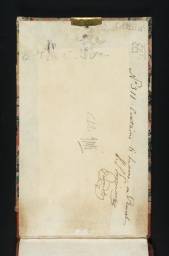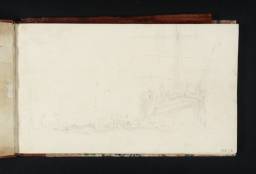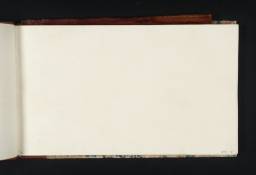Turner Bequest CCI
Post Octavo notebook, bound in marbled paper-covered boards with a brown leather spine, pencil holder and a broken brass clasp
43 leaves of white wove paper with yellow washed edges watermarked ‘R Barnard | 1820’
Approximate paper size 111 x 188 mm1
43 leaves of white wove paper with yellow washed edges watermarked ‘R Barnard | 1820’
Approximate paper size 111 x 188 mm1
The outside front cover is stamped in black ‘CCI’ at the top right, and blindstamped with the Turner Bequest stamp on the leather binding at the upper left. The inside front cover carried the endorsement in brown in by Henry Trimmer, ‘No 311 contains 6 leaves – in pencil | [signed] H.S. Trimmer’ at the top of the page, with Charles Turner’s signature, ‘C Turner’ in brown ink beneath, and inscriptions in pencil by Charles Lock Eastlake, ‘C.L.E’, and John Prescott Knight, ‘JPK’, a the centre of the page. The page is also blindstamped with the Turner Bequest stamp at the centre and inscribed in pencil by A.J. Finberg, ‘CCI’ at the top right and stamped ‘CCI’ in brown ink beneath. Some rectos have the faint remains of John Ruskin’s red ink numbering at the bottom right corner. Finberg noted Turner’s paper label on the spine of the sketchbook, ‘87. King at Edinb.’, and John Ruskin’s endorsement ‘311. Of no value.’ on the wrapper, neither or which are now with the book.
Accepted by the nation as part of the Turner Bequest 1856
As was the Medway sketchbook of the same batch: Tate D17365–D17507; D40691–D40693 complete (Turner Bequest CXCIX); Bower 1999, p.40.
References
Although Turner labelled this sketchbook ‘King at Edinb[urgh]’, it only contains three pages of drawings related to George IV’s visit to Scotland in 1822. In fact, Turner does not seem to have taken this sketchbook to Edinburgh as there are no on-the-spot sketches of Scottish subjects; instead the studies are based on sketches from the King’s Visit to Edinburgh sketchbook (D17508–D17671; D40687–D40688 complete; Turner Bequest CC), from memory, imagination, or in one case, the work of another artist.
The Scottish subjects, however, are significant to Turner’s work as the series of nineteen thumbnail studies on folio 43 verso and the inside back cover (D40979–D40980), Gerald Finley has argued, form the plan for a proposed ‘Royal Progress’ series of paintings (see also folio 1; D17672).2 Turner began painting four of these designs on mahogany boards, but completed only one. (For more information see George IV’s Visit to Edinburgh 1822 Tour Introduction). Three of the designs were also utilised for engraving designs, with the frontispiece vignettes to the two volumes of the 1826 edition of The Provincial Antiquities and Picturesque Scenery of Scotland publication, and an illustration for one volume of an edition of Sir Walter Scott’s Waverley Novels.
These works are
The King’s Departure from the ‘Royal George’ in the Royal Barge, circa 1823 (oil on board, Tate N02880)3
Mission of Sir Walter Scott, circa 1823 (oil on board, Tate N02879)4
George IV at St Giles, Edinburgh, circa 1822 (oil on board, Tate N02857)5
George IV at the Provost’s Banquet, circa 1822 (Tate N02858)6
Design for the frontispiece to volume one of the 1826 edition of the Provincial Antiquities (Tate D13748; Turner Bequest CLXVIII A)
Design for the frontispiece to volume two of the 1826 edition of the Provincial Antiquities (Tate D13749; Turner Bequest CLXVIII B)
March of the Highlanders, circa 1836 (watercolour, Tate N04953), illustration for Fisher’s Illustrations to the Waverley Novels of Sir Walter Scott
The King’s Departure from the ‘Royal George’ in the Royal Barge, circa 1823 (oil on board, Tate N02880)3
Mission of Sir Walter Scott, circa 1823 (oil on board, Tate N02879)4
George IV at St Giles, Edinburgh, circa 1822 (oil on board, Tate N02857)5
George IV at the Provost’s Banquet, circa 1822 (Tate N02858)6
Design for the frontispiece to volume one of the 1826 edition of the Provincial Antiquities (Tate D13748; Turner Bequest CLXVIII A)
Design for the frontispiece to volume two of the 1826 edition of the Provincial Antiquities (Tate D13749; Turner Bequest CLXVIII B)
March of the Highlanders, circa 1836 (watercolour, Tate N04953), illustration for Fisher’s Illustrations to the Waverley Novels of Sir Walter Scott
Five of the other six pages have been identified as sketches on the Thames near Isleworth. Folio 39 verso (D17712) is the only sketch that has been identified with any specificity, as Sion Ferry House and the Pavilion at Isleworth. Two other sketches may show one of the eighteenth- and nineteenth-century mansions by the Thames around Isleworth (folio 40 verso and 42 verso; D17714, D17717). These sketches must have been made between 1820 (the date of the paper’s watermark), and 1826, when Turner sold Sandycombe Lodge, his rural retreat on the Thames. As the royal visit studies can be dated 1822, it is likely that these Thames sketches were also made around this time, perhaps the summer of 1822.
The rest of the sketchbook is empty.
How to cite
Thomas Ardill, ‘King at Edinburgh sketchbook c.1820–3’, sketchbook, November 2008, in David Blayney Brown (ed.), J.M.W. Turner: Sketchbooks, Drawings and Watercolours, Tate Research Publication, December 2012, https://www



